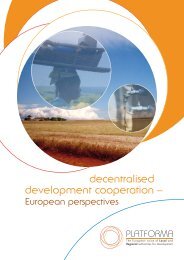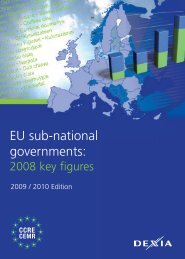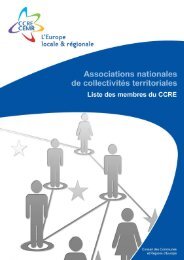Complementarities between urban and rural areas in promoting ...
Complementarities between urban and rural areas in promoting ...
Complementarities between urban and rural areas in promoting ...
You also want an ePaper? Increase the reach of your titles
YUMPU automatically turns print PDFs into web optimized ePapers that Google loves.
COMPLEMENTARITIES BETWEEN URBAN AND RURAL AREAS IN PROMOTING EMPLOYMENT AND SOCIAL INCLUSIONPART 1Initial thoughts on a balanced <strong>urban</strong><strong>and</strong> <strong>rural</strong> development <strong>in</strong> promot<strong>in</strong>gemployment <strong>and</strong> social <strong>in</strong>clusion1. IntroductionBalanced <strong>urban</strong> <strong>and</strong> <strong>rural</strong> development is animportant element to be considered <strong>in</strong> tackl<strong>in</strong>gemployment <strong>and</strong> social <strong>in</strong>clusion <strong>and</strong> should betaken <strong>in</strong>to greater account <strong>in</strong> the EU funded programmespost-2006. While the prevail<strong>in</strong>g socialcontexts differ, <strong>urban</strong> <strong>and</strong> <strong>rural</strong> development donot exist <strong>in</strong> isolation <strong>and</strong> the practical measurestaken to address these problems are often thesame. Cooperation <strong>and</strong> coord<strong>in</strong>ation <strong>between</strong>local government <strong>in</strong> cities <strong>and</strong> <strong>rural</strong> <strong>areas</strong> cancontribute to mutually beneficial solutions <strong>and</strong>can improve the liv<strong>in</strong>g conditions of the population<strong>in</strong> both <strong>areas</strong>.Interdependencies <strong>between</strong> <strong>rural</strong> <strong>and</strong> <strong>urban</strong><strong>areas</strong> vary from region to region <strong>and</strong> are dependanton the spatial <strong>and</strong> structural context oftheir respective <strong>areas</strong>.1.2. TOWARDS A COMPLEMENTARY APPROACHCooperation <strong>between</strong> <strong>urban</strong> <strong>and</strong> <strong>rural</strong> <strong>areas</strong>should create comprehensive social <strong>and</strong> economicbenefits. These <strong>areas</strong> can provide a valuablecomplement to each other. Urban <strong>and</strong> <strong>rural</strong> <strong>areas</strong>can benefit <strong>and</strong> learn from each other <strong>in</strong> termsof the tools <strong>and</strong> processes used <strong>in</strong> order to tacklesocial exclusion <strong>and</strong> unemployment.1.1. INTERDEPENDENCIES BETWEEN URBANAND RURAL AREASTraditionally, <strong>urban</strong> <strong>and</strong> <strong>rural</strong> <strong>areas</strong> have oftenbeen seen as exclusive <strong>areas</strong>. EU structural fundsprojects have, to date, not laid a particularemphasis on <strong>in</strong>tegrat<strong>in</strong>g the different processesof <strong>rural</strong> <strong>and</strong> <strong>urban</strong> employment <strong>and</strong> social <strong>in</strong>clusion.Nevertheless, <strong>in</strong>terdependencies <strong>between</strong><strong>rural</strong> <strong>and</strong> <strong>urban</strong> <strong>areas</strong> have always existed <strong>and</strong>these have become more complex over recentdecades. The <strong>in</strong>creas<strong>in</strong>gly complex relationship<strong>between</strong> <strong>urban</strong> <strong>and</strong> <strong>rural</strong> <strong>areas</strong> is caused bygreater mobility <strong>and</strong> accessibility <strong>between</strong> town<strong>and</strong> country.Cooperation <strong>and</strong> complementary learn<strong>in</strong>g processescan be promoted through networks of<strong>urban</strong> <strong>and</strong> <strong>rural</strong> <strong>areas</strong>. These networks can be ofa regional, <strong>in</strong>terregional or trans-national character,<strong>and</strong> can help to create a more even economic<strong>and</strong> social development. However, meansof cooperation <strong>between</strong> <strong>urban</strong> <strong>and</strong> <strong>rural</strong> <strong>areas</strong>might differ accord<strong>in</strong>g to the vary<strong>in</strong>g structural<strong>and</strong> spatial relationships exist<strong>in</strong>g <strong>between</strong> thesetwo <strong>areas</strong>.— 6 —Interdependencies <strong>between</strong> <strong>urban</strong> <strong>and</strong> <strong>rural</strong><strong>areas</strong> can be described <strong>in</strong> terms of populationflows such as movement of people <strong>in</strong> search foremployment, education <strong>and</strong> tra<strong>in</strong><strong>in</strong>g, or recreation.It is also evident that these <strong>in</strong>terdependenciescan be described <strong>in</strong> terms of structures.














![[ ] Les jumelages pour le monde de demain](https://img.yumpu.com/29721946/1/190x96/-les-jumelages-pour-le-monde-de-demain.jpg?quality=85)

